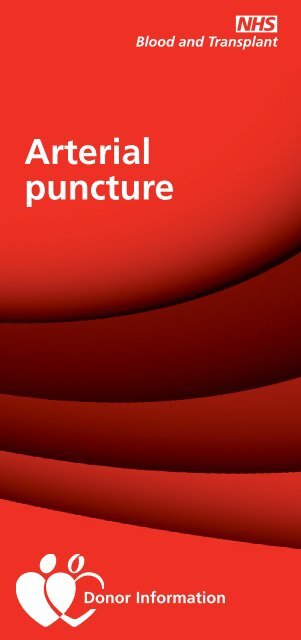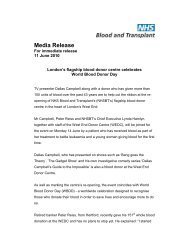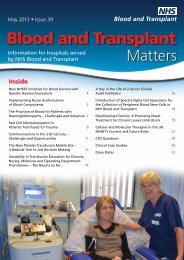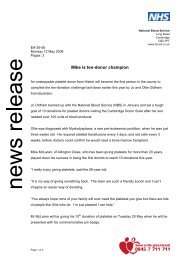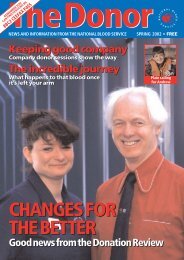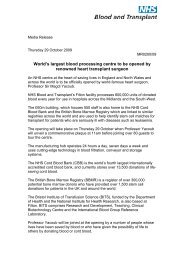Arterial Puncture (PDF, 213K)
Arterial Puncture (PDF, 213K)
Arterial Puncture (PDF, 213K)
You also want an ePaper? Increase the reach of your titles
YUMPU automatically turns print PDFs into web optimized ePapers that Google loves.
<strong>Arterial</strong><br />
puncture<br />
Donor Information
Donor name: ................................<br />
Date of birth: ...............................<br />
Donor number: ............................<br />
Date: .............................................<br />
Time of arterial<br />
puncture:......................................<br />
Site: R / L arm (please circle)<br />
Nurse name:.................................<br />
Signature:.....................................<br />
Additional comments:
Thank you for coming to donate blood<br />
today. We are sorry that a complication<br />
has occurred where the needle was<br />
inserted into an artery rather than a<br />
vein. This rarely happens and our<br />
nurses are trained in dealing with this<br />
complication, however it is important<br />
that if there are any changes you<br />
follow the advice below:<br />
If you are experiencing any of the following<br />
symptoms, raise your arm and apply firm<br />
pressure:<br />
■ Bleeding has restarted.<br />
■ Swelling that is large or increasing in size.<br />
■ Numbness or pins and needles in the arm,<br />
hand or fingers.<br />
■ Severe or worsening pain.<br />
■ Coldness or paleness of the lower arm,<br />
or hand of the affected arm.<br />
Go immediately to the Accident & Emergency<br />
department at your nearest hospital, ask<br />
someone to take you or dial 999 and take<br />
this information with you. A letter for the<br />
A&E doctor is included within this leaflet.<br />
Continue to raise your arm and apply firm<br />
pressure over the site of needle entry on<br />
your way to hospital.
YOU MUST NOT USE THIS ARM TO<br />
DONATE BLOOD IN THE FUTURE<br />
Bruising<br />
It is likely that a bruise will appear after this<br />
has happened. The bruise may look dramatic<br />
and some people can find this worrying,<br />
especially if it appears away from the<br />
donation area. Bruises will disappear with<br />
time but this may take several weeks. It is<br />
normal for bruises to spread out before<br />
fading. If you do experience a bruise the<br />
following advice may help during the first 36<br />
hours after the bruise appeared.<br />
Treat your bruise with RICE!<br />
Rest – allow time for the bruise to heal.<br />
Protect the bruise by avoiding heavy lifting,<br />
e.g. at the gym or carrying heavy shopping,<br />
and only light, gentle movement is<br />
recommended. After 36 hours return to<br />
normal activity.<br />
Ice – do not place directly on the skin but<br />
under a cloth.<br />
Compression – pressing on the point where<br />
the needle was inserted when a bruise has<br />
appeared may reduce the size of the bruise<br />
which is forming.<br />
Elevation – if possible, raise your arm above<br />
the level of your heart when at rest.<br />
www.blood.co.uk
If you require pain relief take paracetamol<br />
(according to manufacturer’s instructions)<br />
but avoid aspirin and ibuprofen for the first<br />
24 hours.<br />
After 36 hours, contrast bathing may help<br />
reduce any swelling. This requires putting<br />
a cold cloth on the affected area for<br />
10 minutes followed by a warm cloth for<br />
10 minutes and repeating this several times,<br />
ending with a cold cloth.<br />
Further information:<br />
If you are worried or require<br />
further information you can<br />
obtain advice by ringing our<br />
donor helpline on<br />
0300 123 23 23<br />
NHS Blood and Transplant is a Special<br />
Health Authority within the NHS.<br />
www.blood.co.uk
TO WHOM IT MAY CONCERN<br />
I am sorry to have to refer this donor to you.<br />
However, at today’s blood donation session<br />
the donor received an arterial puncture rather<br />
than the normal venepuncture required for<br />
venesection. This was done with a 16 gauge<br />
needle.<br />
This is a recognised but rare complication of<br />
blood donation and the majority of these<br />
settle at the session where we manage to<br />
treat them effectively and we do not require<br />
to refer them onwards.<br />
However, a small group have continuing<br />
problems, because of either lack of<br />
haemostasis due to tearing of the artery or<br />
bleeding within the tissues, and may develop<br />
compartment syndrome, pseudo-aneurysms<br />
or just haematoma formation requiring<br />
physiotherapy.<br />
We would be very grateful if you could look<br />
at this donor and follow up as necessary.<br />
Yours sincerely,<br />
Dr S M Barnes FRCP FCEM<br />
Associate Medical Director – Donors<br />
INF809/1 BLC662P Effective date: 19/03/2012


